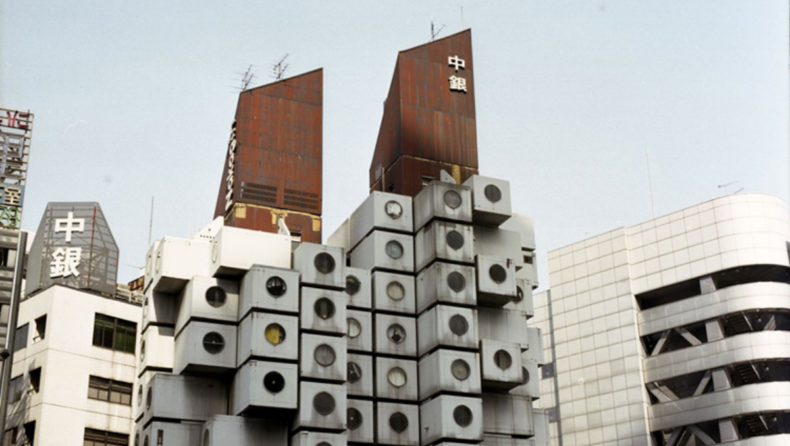The Nakagin Capsule Tower in Japan, which is considered a monument in Japanese architectural history, will be dismantled by mid-April, according to the building’s new owners.
Last year, the owners of the building had announced the plans to dismantle and demolish the tower after years of looking for a buyer who would repair the building and maintain it.
“Ageing has become a huge issue in recent years,” Tatsuyuki Maeda, one of the capsule building’s owners, told a local magazine.
“I was looking for a developer who would rebuild the structure while leaving it standing. We believe it is impossible for the management association to take steps against ageing, such as large-scale renovations,” he said, adding that the Covid-19 pandemic dampened buyer interest in the building.
Why is Japan’s Nakagin Capsule Tower considered iconic?
The Nakagin Capsule Tower, designed by Kisho Kurokawa and completed in 1972, is located in Ginza. The thirteen-story tower is made up of two buildings, each with 140 capsule units.
A small bathroom, television, radio set, kitchen essentials, telephone, furniture, other appliances, and a circular window are all included in each 10-square-metre capsule unit.
Kurokawa intended for the capsules to be replaced once every 25 years when he designed the tower, but repeated ownership difficulties and changes prevented the tower from being repaired. People currently use the buildings mostly as storage or office space.
The Nakagin Capsule Tower was created as a capsule hotel for workers or travellers who did not wish to stay in one area for an extended period of time. The building’s capsule units were designed to be detachable and replaceable from the core framework.
The capsule units are solely attached to the core structure with four high-tension bolts, as planned by Kurokawa, so they can be replaced every 25 years. The capsules can even be linked together to alter the interior if necessary.
During Japan’s Metabolic architecture movement, Kisho Kurokawa was one of the architects who revolutionized architecture.
“We want the capsules to survive, even if in a new form, to keep the metabolic notion alive,” Maeda told The Guardian last year.
The skyscraper has not been maintained in over 33 years, according to ArchDaily, an architecture news organization, resulting in a slew of issues for tenants, including broken water lines.
In 1997, Docomomo International nominated the tower as a world heritage site for Modern Buildings and Sites.
“There’s no denying that the Capsule Tower was famous, but it also had a certain allure that drew people in.” Everyone that stayed was creative in their own way, and the community that grew out of it was incredible. I’m sorry to see it leave, but I’m hoping it will be revived in some manner,” Maeda told the BBC.
About the Metabolism movement?
In the late 1950s and early 1960s, students of Japanese architect Kenzo Tange — Kisho Kurokawa, Fumihiko Maki, Masato Otaka, and Kiyonari Kikutake – brought the wave of modern metabolism architecture to Japan. Following World War II, when cities began to grow and people began to migrate, the wave gathered tremendous speed.
The metabolism movement introduced the idea of creating structures like human beings, where buildings were seen to be ever-changing and their parts were replaceable to extend life, as more people sought living places.
Kisho Kurokawa, who was he?
Kisho Kurokawa, who was born in 1934, earned a bachelor’s degree from Kyoto University. He went on to complete an architecture course at Tokyo University’s Department of Architecture and a master’s degree in architecture at Tokyo University’s Graduate School of Architecture.
The National Ethnological Museum, Hiroshima City Museum of Contemporary Art, the Museum of Modern Art, Osaka International Convention Center (Grand Cube Osaka), Oita Stadium, the Japanese-German Center of Berlin in Germany, Melbourne Central in Australia, Pacific Tower in Paris, France, and the Kuala Lumpur International Airport in Malaysia are some of his major works in Japan and abroad (which has been certified as a sustainable airport). In 1994, the Art Institute of Chicago’s architecture gallery was renamed Kisho Kurokawa Gallery of Architecture.
The Academy of Architecture, France (1986), the 48th Japan Art Academy Award and the AIA Los Angeles Pacific Rim Award are among Kurokawa’s honors.
Kurokawa was also the first Japanese architect to be honored by the Royal Institute of British Architects and the Union of Bulgarian Architects.
In 2006, he received the Walpole Medal of Excellence and the International Architecture Award from the Chicago Athenaeum Museum. Kurokawa, who was 73 at the time of his death, died in 2007.
What does the future hold for the Nakagin Capsule Tower?
A number of the tower’s capsules will be repurposed and shown in museums throughout Japan and the world. Kurokawa constructed a replica of the capsule chamber that is currently on display at the Museum of Modern Art.
Kurokawa’s architecture firm, Kisho Kurokawa architect and colleagues, has indicated an interest in maintaining the tower in a “digital domain.”
“With the dismantling of Kisho Kurokawa’s Nakagin Capsule Tower building, KISHO KUROKAWA architect & associates has signed a Memorandum of Understanding with LAETOLI Co. Ltd., who operates the real estate crowdfunding service “COZUCHI”, for its preservation in digital space, the firm said in a press release. The two companies will work together to achieve its preservation in digital space using the most efficient means possible, which represents Kisho Kurokawa’s concept and mindset.”
“We are determined to preserve the capsules, even if the building is razed,” Maeda added, according to the BBC.
Hundreds of capsules that haven’t aged much will be rescued and repaired.
Published By: JAINAM SHETH
Edited By : KRITIKA KASHYAP












